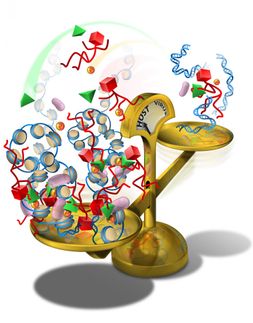Damage control reporters
Advertisement
Damage to the genomic DNA may endanger the whole organism. A new study shows that in the fruit fly Drosophila melanogaster RNA transcripts derived from DNA sequences that have been disrupted by double-strand breaks end up in a deadly embrace.
The double-stranded genomic DNA in each cell is the repository of the genetic information, and specifies the structure of all the proteins needed for cell function. DNA damage can change the information content of the genome and may have serious repercussions for the entire organism.That is why cells possess several repair systems, which are activated when such damage occurs. A research team led by LMU‘s Professor Klaus Förstemann, who works on the fruit fly Drosophila, has discovered a novel cellular response to the presence of double-strand breaks (DSBs) in DNA.
The importance of the correct context
When mutations arise in a DNA strand, the sequence of the other, complementary strand serves as the template for repair of the error. However, in the case of a DSB, the continuity of the double helix is interrupted, and the integrity of the information it encodes is threatened. “These lesions are so dangerous because the likelihood of imprecise repair is higher, and parts of the hereditary information can wind up in the wrong context,” says Förstemann. “We have now shown in Drosophila that this type of damage induces the production of siRNAs. RNA is structurally related to, and synthesized (“transcribed”) from, genomic DNA.
Acting as “short interfering” RNAs, siRNAs are involved in controlling a variety of processes in cells, including gene activity and defense reactions to invading pathogens, and they may have therapeutic potential. However, this is the first time they have been implicated in a response to DNA damage in fruit flies. More detailed analysis revealed the pattern of siRNAs produced. If the lesion occurred in an actively transcribed gene, whose protein product is currently required, then many siRNAs are made - and the stretch of DNA that has been damaged serves as the template for their synthesis.
Pinpointing the gap
Thus the researchers were able to show that all of the siRNAs originate from the region between the gene’s promoter (the starting point for transcription) and the site of the DSB. However, while the normal transcript is a single-stranded RNA that serves as the immediate blueprint for protein synthesis, the siRNAs are derived from a double-stranded precursor that incorporates segments of the potentially corrupted transcripts. “In the cell, the double-stranded RNAs are cut into the shorter siRNAs; these then serve as recognition tags that direct a degradation complex to specifically destroy the potentially defective transcripts of the damaged gene,” says Förstemann.
The investigators suspect that the siRNA response to DSBs may be part of a much more complex process. On the basis of work done in other laboratories, it is known that similar mechanisms are found in plants, fungi and in human cells. “How siRNAs function in the recognition and repair of DNA damage has not been conclusively established,” Förstemann explains.“But clearly, this is a mechanism that has been highly conserved during evolution.”
Original publication
Nucleic Acids Research, 30. Juli 2012






















































